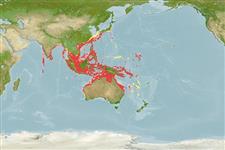Common names from other countries
Environment: milieu / climate zone / depth range / distribution range
Ekologi
marina revassocierade; djupintervall 1 - 100 m, usually 5 - 50 m (Ref. 37816). Tropical; 35°N - 32°S, 72°E - 171°E
Indo-West Pacific: Maldives and India to Papua New Guinea, north to southern Japan, south to Lord Howe Island (Ref. 9710).
Length at first maturity / Size / Vikt / Age
Maturity: Lm ?, range 16 - ? cm
Max length : 25.0 cm TL hane/ej könsbestämd; (Ref. 2272)
Taggstrålar i ryggfenan (totalt) : 8; Mjukstrålar i ryggfenan (totalt) : 13 - 16; Taggstrålar i analfenan: 2; Mjukstrålar i analfenan: 12 - 13. Body compressed, its width 3.3-4 in depth (Ref. 37816). Normally yellow, but sometimes nearly all black and juveniles take-on colors of the local venomous Meiacanthus blennies that are yellow or grey (Ref. 48635).
Found mainly in coastal habitats in semi-silty conditions (Ref. 48635); also found near caves and crevices in rocky and coral reefs from a few meters to at least 100 m. A predator that feeds on surprisingly large prey, swallowed whole through its expandable jaws (Ref. 48635). Feeds mainly on fishes. Secretes the skin toxin grammistin under stress (Ref. 2334).
Life cycle and mating behavior
Maturities | Reproduktion | Spawnings | Egg(s) | Fecundities | Larver
Paxton, J.R., D.F. Hoese, G.R. Allen and J.E. Hanley, 1989. Pisces. Petromyzontidae to Carangidae. Zoological Catalogue of Australia, Vol. 7. Australian Government Publishing Service, Canberra, 665 p. (Ref. 7300)
IUCN Red List Status (Ref. 130435)
CITES (Ref. 128078)
Not Evaluated
Threat to humans
Venomous
Human uses
Fiskeri: kommersiell; Akvarium: Kommersiell
Verktyg
Special reports
Download XML
Internet-källor
Estimates based on models
Preferred temperature (Ref.
115969): 24.6 - 29, mean 28 (based on 1680 cells).
Phylogenetic diversity index (Ref.
82804): PD
50 = 0.7500 [Uniqueness, from 0.5 = low to 2.0 = high].
Bayesian length-weight: a=0.01820 (0.00693 - 0.04780), b=3.04 (2.81 - 3.27), in cm Total Length, based on LWR estimates for this (Sub)family-body shape (Ref.
93245).
Trofisk nivå (Ref.
69278): 4.0 ±0.65 se; based on food items.
Fishing Vulnerability (Ref.
59153): Low vulnerability (15 of 100).
